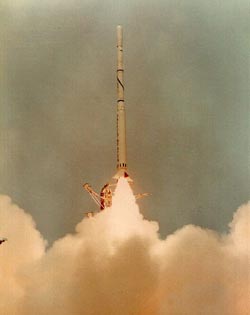|
Flight Control of the Vehicle
 Throughout boost operation of the first three stages, the guidance system controlled the vehicle in pitch, roll, and yaw. Roll and yaw axes were usually maintained constant throughout the boost, but the guidance system was programmed to pitch the vehicle over during boost to achieve the desired trajectory for orbit insertion. During boost of the first stage, control surfaces on the four fins at the base of the first stage controlled the vehicle. The speed of the vehicle was not great enough just after liftoff for these fin control surfaces to be effective; therefore, vanes attached to the fin control shafts extended into the blast area aft of the first stage motor nozzle to provide control by deflecting the high-velocity rocket exhaust. Hydraulic actuators drove the control surfaces and vanes. Because the air was too thin to provide aerodynamic control during the second stage burn, reaction control motors were used to control the second stage in pitch, roll, and yaw. These motors were small rocket nozzles which used hydrogen peroxide fuel. Actuator valves, acting upon command of guidance system signals, pulsed fuel to the reaction motors. The third stage was controlled in the same manner except that the third-stage reaction control motors were smaller because there was less mass to control. After third-stage burnout, the guidance system oriented the third stage in the proper direction for firing the fourth-stage motor for orbit insertion. The fourth stage had no active guidance system. It was stabilized by being spun before it was separated from the third stage. The spinup was accomplished by firing four small solid propellant rockets which spun the fourth stage on a spin bearing relative to the third stage. Throughout boost operation of the first three stages, the guidance system controlled the vehicle in pitch, roll, and yaw. Roll and yaw axes were usually maintained constant throughout the boost, but the guidance system was programmed to pitch the vehicle over during boost to achieve the desired trajectory for orbit insertion. During boost of the first stage, control surfaces on the four fins at the base of the first stage controlled the vehicle. The speed of the vehicle was not great enough just after liftoff for these fin control surfaces to be effective; therefore, vanes attached to the fin control shafts extended into the blast area aft of the first stage motor nozzle to provide control by deflecting the high-velocity rocket exhaust. Hydraulic actuators drove the control surfaces and vanes. Because the air was too thin to provide aerodynamic control during the second stage burn, reaction control motors were used to control the second stage in pitch, roll, and yaw. These motors were small rocket nozzles which used hydrogen peroxide fuel. Actuator valves, acting upon command of guidance system signals, pulsed fuel to the reaction motors. The third stage was controlled in the same manner except that the third-stage reaction control motors were smaller because there was less mass to control. After third-stage burnout, the guidance system oriented the third stage in the proper direction for firing the fourth-stage motor for orbit insertion. The fourth stage had no active guidance system. It was stabilized by being spun before it was separated from the third stage. The spinup was accomplished by firing four small solid propellant rockets which spun the fourth stage on a spin bearing relative to the third stage.
SCOUT LAUNCH VEHICLE DESCRIPTION
Motors and Structure
Flight Control
Sequencing the Flight Events
Stage Separation
Destruct System and Radar Beacon Command Destruct
Electrical Power
Launch History
Launch List
|